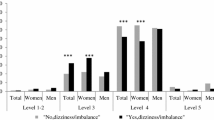Summary
BACKGROUND: The aim of the study was to evaluate health associated attitudes of elderly individuals taking part in a community based health promotion programme. It was of interest to focus on mobility, hypertension and urinary incontinence, problems frequently observed in geriatrics. METHODS: Participants in the health promotion programme were asked to answer a standardized questionnaire about their individual risk factors and habits concerning some of the main risk factors in the elderly: social isolation, immobility, hypertension, urinary incontinence. Mobility and risk assessment for falls was assessed in a standardized way using the Chair-rising- and Timed-upand-go tests. RESULTS: The percentage of people with a healthy life style was significantly higher than in a comparable population group. Gait disturbance, mobility limitation and risk of falls were not present. 38.7 % suffered from urinary incontinence. Hypertension was, if present, diagnosed and adequately treated. The participants knew their prescribed drugs and seemed to have an excellent compliance. DISCUSSION: The participants in the health promotion programme showed an exceptionally high level of health awareness. Nevertheless, the incidence for reported urinary incontinence was significantly higher than in known epidemiological studies. The calm, reassuring atmosphere in which the questionnaire was completed and the large amount of time spent with the participants could explain this finding. The difference in dealing with hypertension and urinary incontinence is obvious. Further health promotion and disease prevention programmes for the elderly should be focused on the complex process of ageing and not only on specific single topics.
Zusammenfassung
EINLEITUNG: Ziel der Studie war es, das Gesundheitsverhalten und das Krankheitsbewusstsein selbstständig lebender älterer Menschen im Rahmen des Gesundheitsförderungsprogramms "Altern mit Hirn und Herz" zu evaluieren und in Relation zu deren individuellen Gesundheitsparametern am Beispiel Hypertonie und Harninkontinenz zu vergleichen. PROBANDEN UND METHODE: Es wurden mittels eines standardisierten Fragebogens Lebensstilfaktoren, Hypertonie, antihypertensive Therapie und Harninkontinenz bei 138 TeilnehmerInnen eines niederflurigen Gesundheitsförderungsprogramms erfragt und die Mobilität mittels eines standardisierten Testprogrammes überprüft. Die Daten wurden deskriptiv analysiert. Hypertonie, Body Mass Index und Harninkontinenz wurden mit dem Alter korreliert. ERGEBNISSE: Der Prozentsatz der TeilnehmerInnen, die einen gesunden Lebensstil pflegten lag deutlich über dem einer vergleichbaren Population. Es bestanden weder Gehstörungen noch Sturzrisiko. 38,7 % litten unter Harninkontinenz. Hypertonie war, wenn sie bestand, bekannt, behandelt und der Blutdruck wurde regelmäßig gemessen. Die Kenntnis der eigenen Blutdruckwerte der Probanden war durchwegs gut, die Compliance bezüglich der antihypertensiven Therapie hoch. DISKUSSION: Die TeilnehmerInnen des Gesundheitsförderungsprogramms "Altern mit Hirn und Herz" und der Fragebogenevaluation ihres Gesundheitsbewusstseins erwiesen sich als durchwegs gesundheitsbewusst. Insbesondere die genaue Kenntnis ihrer Blutdruckwerte und die gute Medikamentencompliance lagen weit über der durchschnittlichen Bevölkerung. Um so erstaunlicher war der hohe Prozentsatz der harninkontinenten Frauen. Die Inzidenz lag deutlich höher als in der Literatur. Dies mag auch auf die ruhige und entspannte Art der Befragung zurückzuführen sein. Die Diskrepanz des Kontinenz und Blutdruckbewusstseins lässt vermuten, dass die Blutdruckkampagnen der letzten Jahre das Bewusstsein von Patienten und betreuenden ärzten geschärft hat, die Frage nach dem Vorhandensein von Harninkontinenz offensichtlich noch immer vernachlässigt wird.
Similar content being viewed by others
Literatur
Sanci L, Glover S, Coffey C (2003) Adolescent health education programmes: theoretical principles in design and delivery. Ann Acad Med Singapore 32: 78–85
Hagemeister J, Schneider CA, Barabas S, Schadt R, Wassmer G, Mager G, Pfaff H, Hopp HW (2001) Hypertension guidelines and their limitations – the impact of physicians' compliance by guideline awareness. J Hypertension 19(11): 2079–2086
Wolfram RM, Budinsky AC, Husslein P, Hoppichler F, Kritz H, Sinzinger H (2002) Awareness of Austrian physicians of risk factors for the development of artherosclerosis. Wien Klin Wochenschr 114(17–18): 773–780
Madersbacher St (2000) Prevalence of lower urinary tract symptoms and urinary incontinence in the elderly: Recent data from Austria. Wien Klin Wochenschr 112/9: 379–380
Maggi S, Minicuci N, Langlois J, Pavan M, Enzi G, Crepaldi G (2001) Prevalence rate of urinary incontinence in community-dwelling elderly individuals: the Veneto study. J Gerontol A Biol Sci Med Sci 56A: M14–M18
Finkelstein MM, Skelly J, Kczorowski J, Swanson G (2002) Incontinence Quality of Life Instrument in a survey of primary care physicians. J Fam Pract 51(11): 952
Sampselle CM, Harlow SD, Skurnick J, Brubaker L, Bondarenko I (2002) Urinary incontinence predictors and life impact in ethnically diverse perimenopausal women. Obstet Gynecol 100(6): 1230–1238
Sandvik H (1999) Health information and interaction on internet: a survey of female urinary incontinence. BMJ 319: 29–32
Fries JF (1980) Ageing, natural death, and the compression of morbidity. NEJM 313: 407–428
Fries JF (1996) Physical activity, the compression of morbidity and the health of the elderly. J R Soc Med 89: 64–68
Podsiadlo D, Richardson S (1991) The Timed up & go: A test of basic functional mobility for frail elderly persons. Am Geriatr Soc 39: 142–148
Guralnik JM, Ferrucci L, Simonsick EM, Salive ME, Fallace RB (1995) Lower-extremity function in persons over the age of 70 years as a predictor of subsequent disability. N Engl J Med 332(9): 556–562
Author information
Authors and Affiliations
Corresponding author
Rights and permissions
About this article
Cite this article
Pils, K., Neumann, F. Unterschiedliches Gesundheitsverhalten bezüglich Bluthochdruck und Harninkontinenz bei gesundheitsbewusst lebenden älteren Menschen. Wien Med Wochenschr 156, 158–161 (2006). https://doi.org/10.1007/s10354-006-0271-z
Received:
Accepted:
Issue Date:
DOI: https://doi.org/10.1007/s10354-006-0271-z




